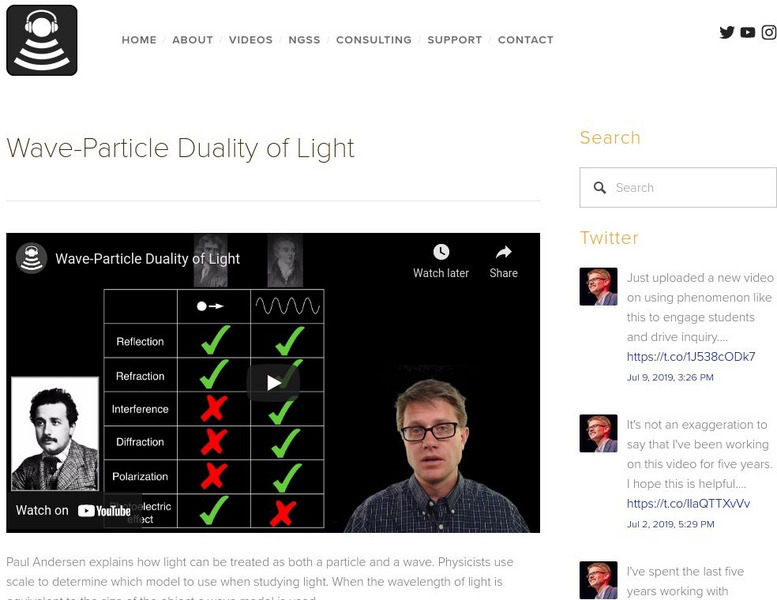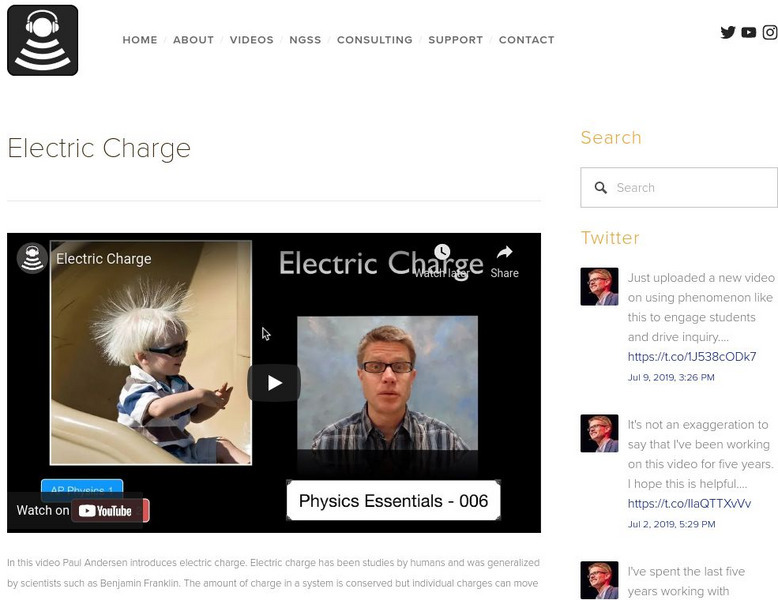Bozeman Science
Meiosis
An informative video overviews haploid versus diploid cells, how meiosis, fertilization, and mitosis all work together, how mitosis and meiosis differ in their processes and end results, and concludes with a brief discussion about...
Bozeman Science
Interstitial Fluid
Humans have more interstitial fluid than blood, but what is interstitial fluid? The video allows learners to understand interstitial fluid by seeing it in a photo, learning its definition, showing where it comes from thanks to...
Bozeman Science
Enzymes
Hydrogen peroxide bubbles might look painful on a cut, but they are actually doing an important job. The video explores enzymes by allowing learners to see active sites on enzymes and how substrates, like a key fitting a lock, fit...
Bozeman Science
Endosymbiosis
If life on Earth began as a prokaryote, how did eukaryotic cells arise? Learners explore the history of endosymbiosis from Dr. Lynn Margulis' first writings, which were not widely received to the evidence of mitochondrial DNA. They then...
Bozeman Science
Effects of Changes in Pathways
Toxins, poisons, and diseases, oh my! These forces work throughout the body to disrupt the normal processes causing harm, or even death. Learners see how toxins, poisons such as anthrax, and diseases such as diabetes affect the normal...
Bozeman Science
Cellular Specialization
Embryonic stems cells were only first discovered in 1998 — less than 20 years ago. The video explains what stem cells are (both pluripotent and totipotent), how they become specific types of tissues cells via internal cues such as the...
Bozeman Science
Coupled Relations
Energy from the sun travels millions of miles, and actually helps you move your thumb. Observe how reactions work together to release and consume energy, such as the power of a river grinding grains, which allows processes to occur....
Bozeman Science
Cellular Respiration
ATP — it's everywhere! The video describes aerobic and anaerobic respiration, how the processes of glycolysis, the Kreb cycle, and the Electron Transport Chain work inside the cells to produce ATP, and ends with a discussion about...
Bozeman Science
Bioenergetics
Life requires energy, for without it, you will die! Learners watch a video to see how organisms use free energy, gain knowledge about Gibbs free energy, and observe how free energy plays a role in both photosynthesis and cellular...
Bozeman Science
Adenosine Triphosphate
In this second video, viewers learn the structure of ATP, then watch how our bodies use ATP to provide us with the energy we need at the cellular level. At the end, they learn how all organisms in life, even from the...
Bozeman Science
Anaerobic Respiration
Just when you thought you had a good grasp of aerobic respiration, in the presence of oxygen, you learn that respiration can occur without oxygen. What?! In the video, learners see how organisms, in the absence of oxygen, can survive...
Bozeman Science
What is Physics?
Name that physicist! In the video lesson, Mr. Andersen introduces scholars to the classical physicists that began the branch of science called physics. He also explains the different branches of physics and talks about how to use science...
Bozeman Science
Bozeman Science: Elementary Charge
Paul Andersen explains how electric charge is quantized and how the smallest unit of charge is 1.6x10^-19 C, or the elementary charge. [4:51]
Bozeman Science
Bozeman Science: Newton's Third Law
Paul Andersen explains how Newton's Third Law applies to all objects. [6:01]
Bozeman Science
Bozeman Science: The New Ap Biology Exam a Users Guide
In this video user guide, science teacher, Paul Andersen, describes the scoring and the two parts of the new AP Biology Exam which is different from all previous exams. [13:09]
Bozeman Science
Bozeman Science: Inertial Mass
Paul Andersen explains how inertial mass is defined and measured in context of Newton's second law of motion. [4:30]
Bozeman Science
Bozeman Science: Wave Particle Duality of Light
In the following video Paul Andersen explains how light can be treated as both a particle and a wave. Physicists use scale to determine which model to use when studying light. When the wavelength of light is equivalent to the size of the...
Bozeman Science
Bozeman Science: Ps3 C Relationship Between Energy and Forces
In this video Paul Andersen describes the relationship between energy and forces. When objects are directly touching electromagnetic forces can result in forces and energy exchange. When objects are not directly touching fields;...
Bozeman Science
Bozeman Science: Natural Resources
In this video Paul Andersen explains how the resources required for survival come from the Earth. The resources are not evenly distributed on the planet and neither are the humans.
Bozeman Science
Bozeman Science: Ap Physics: Objects & Systems
Paul Andersen explains the differences between a system and an object as it relates to physics. [4:50]
Bozeman Science
Bozeman Science: Ap Physics: Objects
Find out how a system can be viewed as an object and an object can be viewed as a system. [4:10]
Bozeman Science
Bozeman Science: Ap Physics: Electric Charge
Paul Andersen introduces electric charges. The amount of charge in a system is conserved but individual charges can move through a conductor as current. [4:19]
Bozeman Science
Bozeman Science: Ap Physics: Positive & Negative Charge
Mr. Andersen illustrates and explains how all objects contain positive and negative charge. [5:24]
Bozeman Science
Bozeman Science: Gravitational Mass
Paul Andersen explains how the gravitational mass is a measure of the force on an object in a gravitational field. [6:02]























